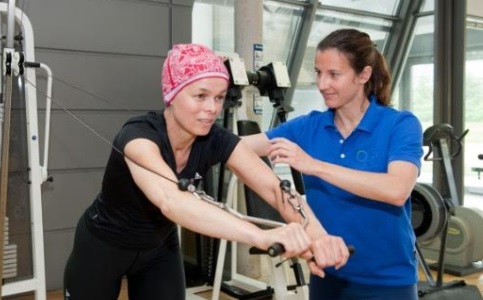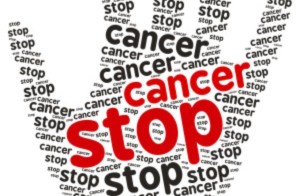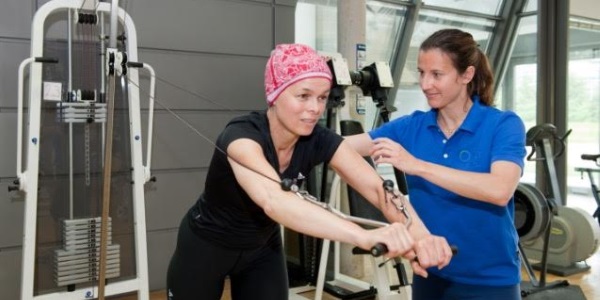
Written by Christan Hartford
Cancer is one of the most common health concerns across the world. In fact, approximately 12.7 million people are diagnosed with cancer each year. However, the more important statistic is that 33% of cancer cases can be prevented through early treatment and healthy lifestyle choices (1). This same concept remains consistent with patients who are undergoing treatment.
 Treatment Overview
Treatment Overview
The two main types of cancer treatment are chemotherapy and radiation. Chemotherapy is intravenous treatment in which travel through the body on a mission to kill cancer cells. Radiation used high energy waves to kill cancer cell and shrink tumors. Both of these treatments are highly successful, but they also entail a lot of negative side effects (2).
Chemotherapy and radiation have common side effects. Chemo typically results in nausea and vomiting, loss of appetite, weakened immune system, hair loss, and extreme fatigue. Radiation is known to cause fatigue, muscle soreness, and skin irritation (2). The loss of appetite, nausea, muscle soreness, and fatigue are the most debilitating due to the fact they prevent the patient from living their normal life. I saw this happen when my friend had cancer. He went from a healthy, energetic guy who followed a balanced diet and regimented workout schedule to a guy who had trouble eating and walking more than a mile. Unfortunately, during treatment these side effects do not go away with just rest and relaxation. A patient must attack the side effects just like they are attacking the cancer by practice a healthy, active life style.

Research shows cancer can be prevented in a third of the patients affected by it with exercise.
Get Up and Feel Good
Exercising during cancer treatment is a difficult task, but it is a very important part to the recovery process. First of all, in any case, a patient should always discuss the matter with his or her doctor before starting an exercise routine. With that said, research has shown no harmful effects on cancer patients with moderate exercise. In fact, consistent moderate exercise has been shown to reduce fatigue feelings by 40-50% (3). Carol Harrison, senior exercise physiologist at The University of Texas, says, “Exercise has the potential to help reduce some of the fatigue experienced during and after treatment, especially if you’re undergoing radiation therapy. And, it can help prevent weight gain commonly experienced during chemotherapy treatment” (4). Exercise has been known to improve one’s psychological outlook while in stressful situations. Exercise releases endorphins and regulates hormone levels, which improves one’s emotional and psychological state (4).
The American Cancer Society strongly recommends that patients and survivors return to normal daily activities as soon as possible. They also advise including strength building exercises twice a week, and 150 minutes of moderate intensity aerobic exercise or 75 minutes of high intensity exercise per week (4).
You Must Walk Before You Run
I mean that both figuratively and literally. Figuratively speaking, you need to take your time and ease back into physical activity. Literally, you need to start walking before you ever even think about jogging. Some different methods of aerobic exercise for cancer patients are:
- Walking
- Stationary Bike
- Elliptical
- Treadmill walking
- Rowing Machine
- Stairs
All of these methods can be used for low to moderate intensity exercise. If you can make it to a gym, biking, rowing, elliptical, and treadmill are the best options. It is good to consistently change machines in order to put your body through new challenges. If you cannot make it to a gym, a home stationary bike would be a great investment. If you cannot buy one of those, walking around the neighborhood or up and down the stairs at home are both great ideas. When you are comfortable with moderate intensity, simply increase your speed and decrease your time duration in order to make it high intensity exercise.
Bodyweight Exercises to Heal the Body
The American Cancer Society recommends two days of strength training each week, as long as the doctor approves it. Most people immediately think of lifting weights when they hear strength training. However, for cancer patients, bodyweight exercises are the perfect way to start. Bodyweight exercises are great because you can do them in the comfort of your own home, they do not fatigue the nervous system, and they do not leave you as sore as traditional weight lifting. Bodyweight exercises include:
- Squats
- Lateral Squats
- Glute Bridges (Double and Single Leg)
- Lunges
- Sit-ups
- Push-ups (on the knees if necessary)
- Planks
- The list can go on forever depending on your creativity
Bodyweight exercises are a great starting point for cancer patients to increase total body strength. IT IS VERY IMPORTANT THAT YOU DO THESE WITH PROPER TECHNIQUE! When you get comfortable with bodyweight exercises, you can do the same exercises with bands or dumbbells.
It is very important to focus on strengthening the lower body musculature and the core (your entire torso, not just your abs). During treatment, patients usually sit more than normal resulting in atrophy of lower body and core muscles. Strengthening these muscles will allow you to get back to daily activities much faster.
Set Goals
Setting exercise goals is a very important step to getting healthier during the treatment process. If you walk .5 miles within a few days after treatment, you should attempt to walk .6 or higher the next day. If you walk up and down the steps 10 times, you should aim to walk 11 times the next day. Setting goals is important because it ensures that you are progressing. Also, your attitude will be more positive and your psychological outlook will improve when you accomplish a personal goal every single day! Set goals, reach goals, and beat cancer!
YOU CAN DO IT
I know that cancer treatments can wipe you out. They make you feel tired, nauseas, and sad. I do not know what cancer treatment feels like, but I do know that physical activity has the potential to lessen the severity of the side effects. Whether it is a 40-50% decrease in fatigue levels or an overall better attitude about the treatment process, exercise is a powerful weapon that all cancer patients should have in their arsenal. As hard as it is to start exercising after treatment, it is advantageous in the fight against cancer!
I urge all readers, patients, family members, or friends, to pass the message on to others. No body can beat cancer alone. Help loved ones affected by cancer get back to their normal life. Educate them on the importance of exercise, exercise with them, make sure they set goals, and help them achieve those goals. WE CAN BEAT THIS ONE WALK AT A TIME, ONE BIKE RIDE AT A TIME, ONE EXERCISE AT A TIME!
References
- Huffington Post. “World Cancer Day: 340,000 Cases of Cancer A Year In The U.S. Could Be Prevented”. Published 2/4/2011. http://www.huffingtonpost.com/2011/02/04/world-cancer-day-a-declar_n_818472.html
- American Cancer Society. “What are the different types of cancer treatments”. http://www.cancer.org/treatment/understandingyourdiagnosis/talkingaboutcancer/ whensomeoneyouworkwithhascancer/when-someone-you-work-with-has-cancer-questions-and-answers-about-cancer-treatment
- National Comprehensive Cancer Network. “Exercising During Cancer Treatment”. https://www.nccn.org/patients/resources/life_with_cancer/exercise.aspx
- The University of Texas MD Anderson Cancer Center. “4 Tips for exercising during cancer treatment”. https://www.mdanderson.org/publications/cancerwise/2014/07/four-tips-for-exercising-during-cancer-treatment.html
